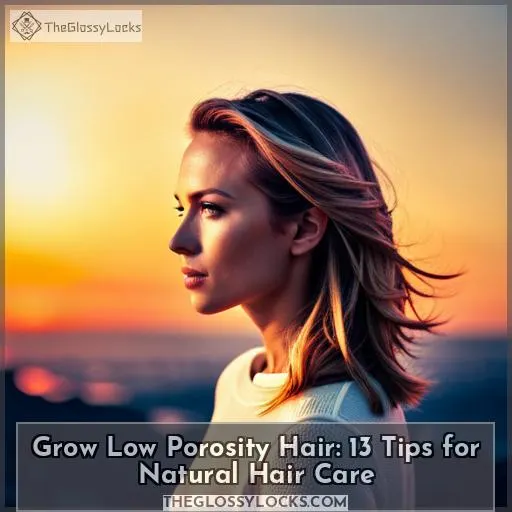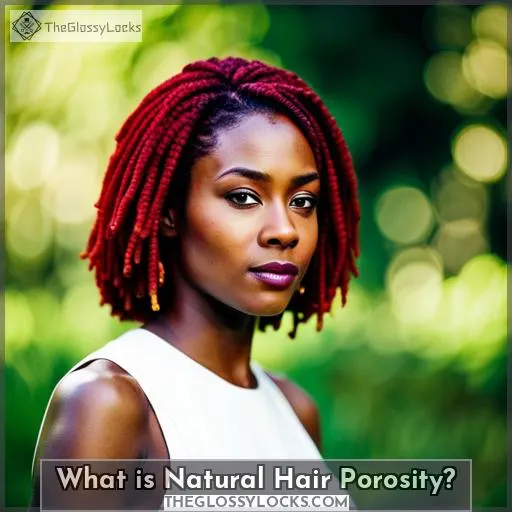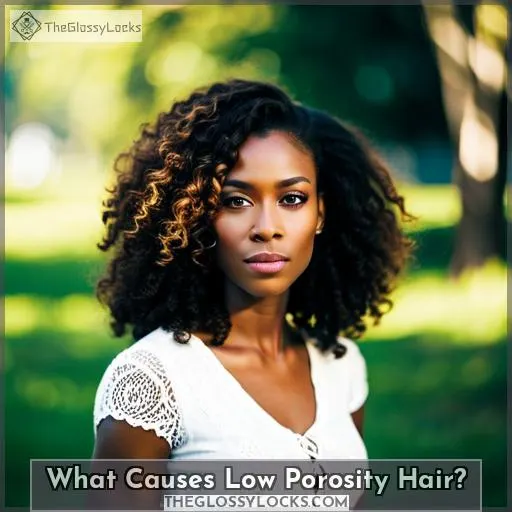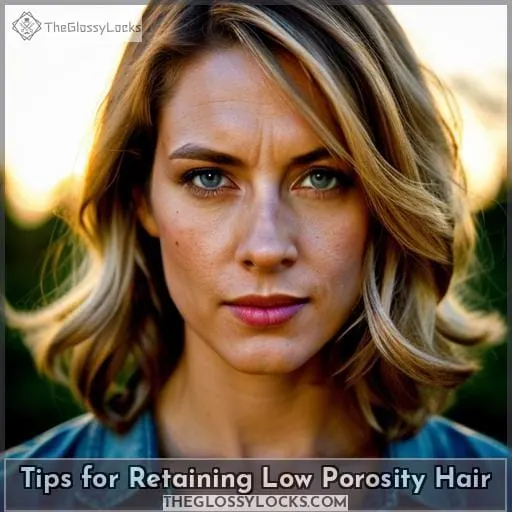This site is supported by our readers. We may earn a commission, at no cost to you, if you purchase through links.
Once upon a time, in the faraway kingdom of curly hair, there lived a princess with low porosity hair. She was constantly struggling to find ways to grow her locks despite the fact that her cuticles were tightly bound together and refused to absorb moisture, no matter how hard she tried.
Her quest for knowledge on how to grow low porosity hair had become an arduous journey until one faithful day when she stumbled upon some tips that worked wonders! Now you too can learn from the wisdom this brave princess discovered as we take you through all 13 tips for growing and maintaining healthy natural curls with low porosity!
Table Of Contents
- Key Takeaways
- What is Natural Hair Porosity?
- What Causes Low Porosity Hair?
- The Recipe for Growing Low Porosity Hair
- How to Know if You Have Low Porosity Hair
- Tips for Retaining Low Porosity Hair
- Frequently Asked Questions (FAQs)
- What can I do to improve the health of my low porosity hair?
- Are there any styling products specifically for low porosity hair?
- How often should I deep condition my low porosity hair?
- Should I use a hood dryer or a blow dryer for low porosity hair?
- Does low porosity hair require more or less moisture than other hair types?
- Conclusion
Key Takeaways

- Minimize heat styling and excessive use of hot tools to prevent further sealing of the cuticles.
- Use moisturizing treatments, lightweight oils, and heat protection to nourish and hydrate low porosity hair.
- Incorporate protein treatments and oil treatments to open up the cuticles and provide hydration for low porosity hair.
- Opt for specialized products, such as lightweight conditioners and deep conditioning masks, formulated for low porosity hair to maintain its health and manageability.
What is Natural Hair Porosity?
Understanding the natural porosity of your hair is key to knowing how best to care for it and achieve healthy, manageable results. Hair porosity refers to the ability of a strand’s cuticles or outer layer, which helps determine moisture balance in hair.
Low porosity means that the cuticle layer lies flat tightly against each other, making product penetration difficult. However, it also provides protection from heat damage and environmental influences such as sun exposure or air pollutants.
For low-porosity strands, protein treatments can help open up these tight seals, while oil treatments can give added hydration without weighing down your tresses too much due to their small molecular size being able to penetrate more easily into those tight layers on low-porosity natural hair.
Heat styling should be kept at a minimum with this type since high temperatures tend to further seal off these already closed cuticles, resulting in dryness and frizziness over time if not done carefully.
To keep your mane looking its best, use lightweight conditioners formulated specifically for low-porosity locks, along with regular deep conditioning masks containing both proteins and oils for maximum benefit! With proper maintenance, you’ll have no problem growing out luscious long curls that will make heads turn everywhere you go!
What Causes Low Porosity Hair?
Knowing the causes of your hair’s low porosity can help you to better manage it, resulting in tresses that are both healthy and lustrous. Low porosity is caused by a tightly sealed cuticle layer, which makes product penetration difficult.
This tight outer layer also provides protection from heat damage and environmental influences, such as sun exposure or air pollutants.
To prevent this issue, use lightweight oil-based products on your hair to keep the cuticles open, while avoiding too much heat styling. High temperatures can further seal off these already closed cuticles, leading to dryness and frizziness over time if not done carefully.
Additionally, regular deep conditioning masks containing both proteins and oils will provide maximum benefit for keeping those luscious locks looking great all year round! With proper maintenance of low porosity strands through using the right products, along with preventive measures like avoiding excessive heat styling, you’ll be able to achieve beautiful long curls that have everyone turning their heads whenever they catch a glimpse!
The Recipe for Growing Low Porosity Hair
By taking the right steps, you can unlock your hair’s full potential and show off its beautiful texture! Start with a good moisturizing treatment to help hydrate and nourish your low porosity locks. Use lightweight oils that will penetrate deep into each strand for maximum effect.
Also, don’t forget heat protection, which is essential to prevent damage from hot tools like curling irons or blow dryers.
Additionally, make sure to incorporate regular deep conditioning masks containing proteins and oils into your routine. This helps keep those luscious locks looking great throughout the year! To further enhance scalp care, add fatty acids such as avocado oil or jojoba oil to strengthen strands at their roots.
Lastly, use natural hair-friendly brushes when styling instead of plastic combs. Not only are they gentler on delicate strands, but they also have less static electricity buildup than synthetic alternatives.
Drink plenty of water daily – it’s an easy way for healthy tresses! With these tips in mind, plus using specially formulated low porosity hair products available online or from drug stores near you, there won’t be any stopping you from showing off gorgeous spirals all around town.
How to Know if You Have Low Porosity Hair
If you want to know if you have low porosity hair, the best way to test it is by performing a simple water drop test. To do this, take a single strand of your hair and place it on top of some clear glass or plastic.
Next, add one drop of water onto your strand and observe how long it takes for the droplet to absorb into your hair. Typically, with low porosity strands, the water will sit on top without absorbing quickly.
To further confirm that you have this type of texture, try moisturizing techniques like rice wash or deep conditioning treatments using good fats such as avocados.
Additionally:
- Using specialized products designed specifically for those with Low Porosity Hair is essential in order to maintain a healthy scalp and reduce damage from protective styling methods.
- Try varying amounts of shampoo when washing since too much can build up over time.
- Consider adding oils directly after cleansing while wet so they penetrate better.
- Pay attention to how fast (or slowly) moisture evaporates from each section during styling. This can be an indicator of whether certain areas may need more hydration than others.
Tips for Retaining Low Porosity Hair
Retaining your hair’s natural levels of hydration can be tricky when you have low porosity hair, but with the right techniques and products, achieving softness and manageability is entirely possible.
To maintain healthy curls while styling, here are some tips:
- Incorporate deep conditioning treatments that contain proteins small enough to penetrate into the strands.
- Invest in quality hair oils, such as Olaplex’s Hair Perfector No. 3, which helps repair damaged bonds within the follicle itself. This is perfect for those dealing with heat-styling damage or environmental factors like pollution or sun exposure.
- Moisturize regularly using Avocado Moisturizing Hair Milk. It replenishes lost moisture without weighing down your locks!
- Avoid over-drying by limiting how often you use hot tools. Instead, try air drying your hair. Also, always protect your scalp from unnecessary friction during blowouts or other styling sessions.
- Don’t forget to finish each styling session with a cool shot to lock in your style.
Taking these steps will help keep your tresses looking their best, no matter what type of textured mane you possess.
Frequently Asked Questions (FAQs)
What can I do to improve the health of my low porosity hair?
To improve the health of your low porosity hair, use nourishing shampoos and conditioners such as Redken All Soft Argan Oil or Camille Rose Sweet Ginger Rinse. Moisturize with Avocado Jojoba Moist Conditioner and Miracle RepaiRx Leave-In Conditioner.
Are there any styling products specifically for low porosity hair?
Yes! Look for products specifically designed to nourish and hydrate low porosity hair. They will help improve overall health, provide soft and shiny results, reduce frizz and static, lock in style – all while protecting your hair from damage.
How often should I deep condition my low porosity hair?
Deep condition your low porosity hair every two to four weeks. Use a moisturizing deep conditioning mask and apply it from root to tip, leaving it on for at least 30 minutes. Rinse thoroughly with lukewarm water and finish by applying a leave-in conditioner for extra hydration.
Should I use a hood dryer or a blow dryer for low porosity hair?
For low porosity hair, using a hood dryer is best. It offers more coverage and adjustable heat settings to help lock in moisture and reduce frizz.
Does low porosity hair require more or less moisture than other hair types?
Low porosity hair requires more moisture than other hair types. It needs extra hydration, which can be provided with a leave-in conditioner or deep conditioning treatments.
Conclusion
Are you ready to rock your low porosity hair? With the right products, techniques, and know-how, you can have the most amazing hair you’ve ever dreamed of. With the right care, your hair will look luscious like never before – you’ll be the envy of everyone around you! Don’t let your low porosity hair hold you back – get out there and show it off! And it will be so fabulous, you’ll be sure to turn heads.
With the incredible products and tips offered here, you can get your hair looking healthier and more beautiful than ever.








